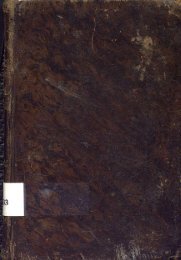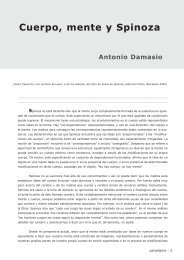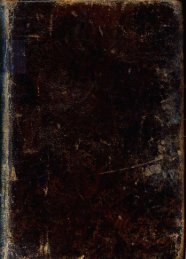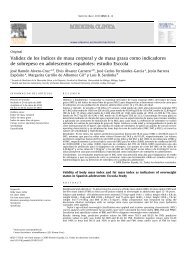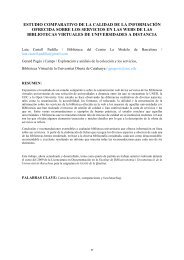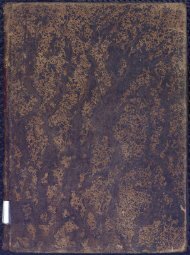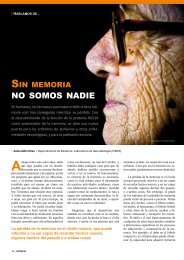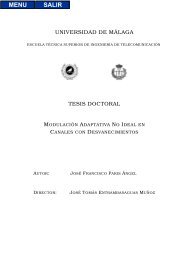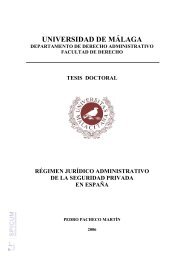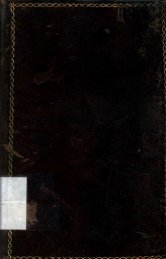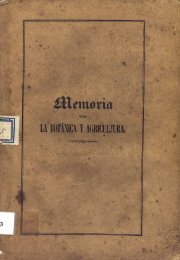Papel de las actividades superóxido dismutasa y catalasa en la ...
Papel de las actividades superóxido dismutasa y catalasa en la ...
Papel de las actividades superóxido dismutasa y catalasa en la ...
Create successful ePaper yourself
Turn your PDF publications into a flip-book with our unique Google optimized e-Paper software.
Journal of Fish Diseases 2006, 29, 355–364<br />
Superoxi<strong>de</strong> dismutase and cata<strong><strong>la</strong>s</strong>e activities<br />
in Photobacterium damse<strong>la</strong>e ssp. piscicida<br />
P Díaz-Rosales, M Chabrillón, S Arijo, E Martinez-Manzanares, M A MoriÇigo<br />
and M C Balebona<br />
Departm<strong>en</strong>t of Microbiology, Faculty of Sci<strong>en</strong>ces, University of Má<strong>la</strong>ga, Ma<strong>la</strong>ga, Spain<br />
Abstract<br />
The ability of a set of Photobacterium damse<strong>la</strong>e ssp.<br />
piscicida strains iso<strong>la</strong>ted from differ<strong>en</strong>t fish species to<br />
produce differ<strong>en</strong>t superoxi<strong>de</strong> dismutase (SOD) and<br />
cata<strong><strong>la</strong>s</strong>e <strong>en</strong>zymes was <strong>de</strong>termined. Unlike other bacterial<br />
pathog<strong>en</strong>s, P. damse<strong>la</strong>e ssp. piscicida is not able<br />
to produce differ<strong>en</strong>t isoforms of SOD or cata<strong><strong>la</strong>s</strong>e<br />
containing differ<strong>en</strong>t metal cofactors wh<strong>en</strong> cultured<br />
un<strong>de</strong>r oxidative stress induced by hydrog<strong>en</strong> peroxi<strong>de</strong><br />
or methyl violog<strong>en</strong>, or un<strong>de</strong>r iron <strong>de</strong>pleted conditions.<br />
However, iron cont<strong>en</strong>t of the growth medium<br />
influ<strong>en</strong>ced the levels of SOD and cata<strong><strong>la</strong>s</strong>e activity in<br />
cells, these levels <strong>de</strong>creasing with iron avai<strong>la</strong>bility of<br />
the medium. Comparison of virul<strong>en</strong>t and non-virul<strong>en</strong>t<br />
strains of P. damse<strong>la</strong>e ssp. piscicida showed simi<strong>la</strong>r<br />
cont<strong>en</strong>ts of SOD, but higher levels of cata<strong><strong>la</strong>s</strong>e<br />
were <strong>de</strong>tected in cells of the virul<strong>en</strong>t strain. Incubation<br />
of bacteria with sole, Solea s<strong>en</strong>egal<strong>en</strong>sis (Kaup),<br />
phagocytes has shown that survival rates range from<br />
19% to 62%, these rates being higher for the virul<strong>en</strong>t<br />
strain. The increased levels of cata<strong><strong>la</strong>s</strong>e activity<br />
<strong>de</strong>tected in the virul<strong>en</strong>t strain indicates a possible role<br />
for this <strong>en</strong>zyme in bacterial survival.<br />
Keywords: cata<strong><strong>la</strong>s</strong>e, phagocyte, Photobacterium<br />
damse<strong>la</strong>e subsp, Solea s<strong>en</strong>egal<strong>en</strong>sis, superoxi<strong>de</strong><br />
dismutase, virul<strong>en</strong>ce.<br />
Introduction<br />
Photobacterium damse<strong>la</strong>e ssp. piscicida is a pathog<strong>en</strong><br />
responsible for important losses in fish<br />
Correspon<strong>de</strong>nce Prof. M C Balebona, Departm<strong>en</strong>t of<br />
Microbiology, Faculty of Sci<strong>en</strong>ces, University of Ma<strong>la</strong>ga, 29071<br />
Ma<strong>la</strong>ga, Spain<br />
(e-mail: balebona@uma.es)<br />
aquaculture worldwi<strong>de</strong>. The importance of extracellu<strong>la</strong>r<br />
products, the pres<strong>en</strong>ce of iron uptake<br />
mechanisms and the capsu<strong>la</strong>r material as virul<strong>en</strong>ce<br />
factors in P. damse<strong>la</strong>e ssp. piscicida are well<br />
docum<strong>en</strong>ted (Magariños, Romal<strong>de</strong>, Bandín, Fouz<br />
& Toranzo 1992; Magariños, Pazos, Santos,<br />
Romal<strong>de</strong> & Toranzo 1994; Magariños, Romal<strong>de</strong>,<br />
Lemos, Barja & Toranzo 1995; Arijo, Borrego,<br />
Zorril<strong>la</strong>, Balebona & Moriñigo 1998). However,<br />
information concerning mechanisms involved in<br />
the invasion and survival insi<strong>de</strong> the host is scarce<br />
and results regarding interaction of P. damse<strong>la</strong>e<br />
ssp. piscicida with phagocytes have be<strong>en</strong> contradictory.<br />
While some authors have reported the<br />
pres<strong>en</strong>ce of intact bacteria insi<strong>de</strong> fish cells,<br />
suggesting the ability of P. damse<strong>la</strong>e to survive as<br />
an intracellu<strong>la</strong>r pathog<strong>en</strong> (Kubota, Kimura &<br />
Egusa 1970; Nelson, Kawahara, Kawai & Kusuda<br />
1981; Kusuda & Sa<strong>la</strong>ti 1993; Noya, Magariños &<br />
Lamas 1995a; Noya, Magariños, Toranzo &<br />
Lamas 1995b), others have observed that this<br />
pathog<strong>en</strong> is highly susceptible to oxidative radicals<br />
g<strong>en</strong>erated during the macrophage respiratory burst<br />
(Skarmeta, Bandín, Santos & Toranzo 1995; Arijo<br />
et al. 1998).<br />
The reactive oxyg<strong>en</strong> species (ROS), such as<br />
hydrog<strong>en</strong> peroxi<strong>de</strong> (H 2 O 2 ) and superoxi<strong>de</strong> anion<br />
(O 2 ), are produced by phagocytes in response to<br />
microbial infection. ROS constitute an important<br />
compon<strong>en</strong>t of the innate active <strong>de</strong>f<strong>en</strong>ce response<br />
against invading microorganisms by fish phagocytic<br />
cells. Therefore, bacterial pathog<strong>en</strong>s must<br />
overcome the toxic effects of ROS to establish<br />
infections. Microorganisms have evolved systems<br />
to protect themselves from these highly toxic<br />
radicals. One of these protective pathways involves<br />
the production of <strong>de</strong>toxifying <strong>en</strong>zymes such as<br />
Ó 2006<br />
B<strong>la</strong>ckwell Publishing Ltd<br />
355



